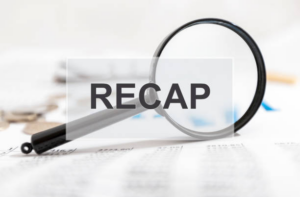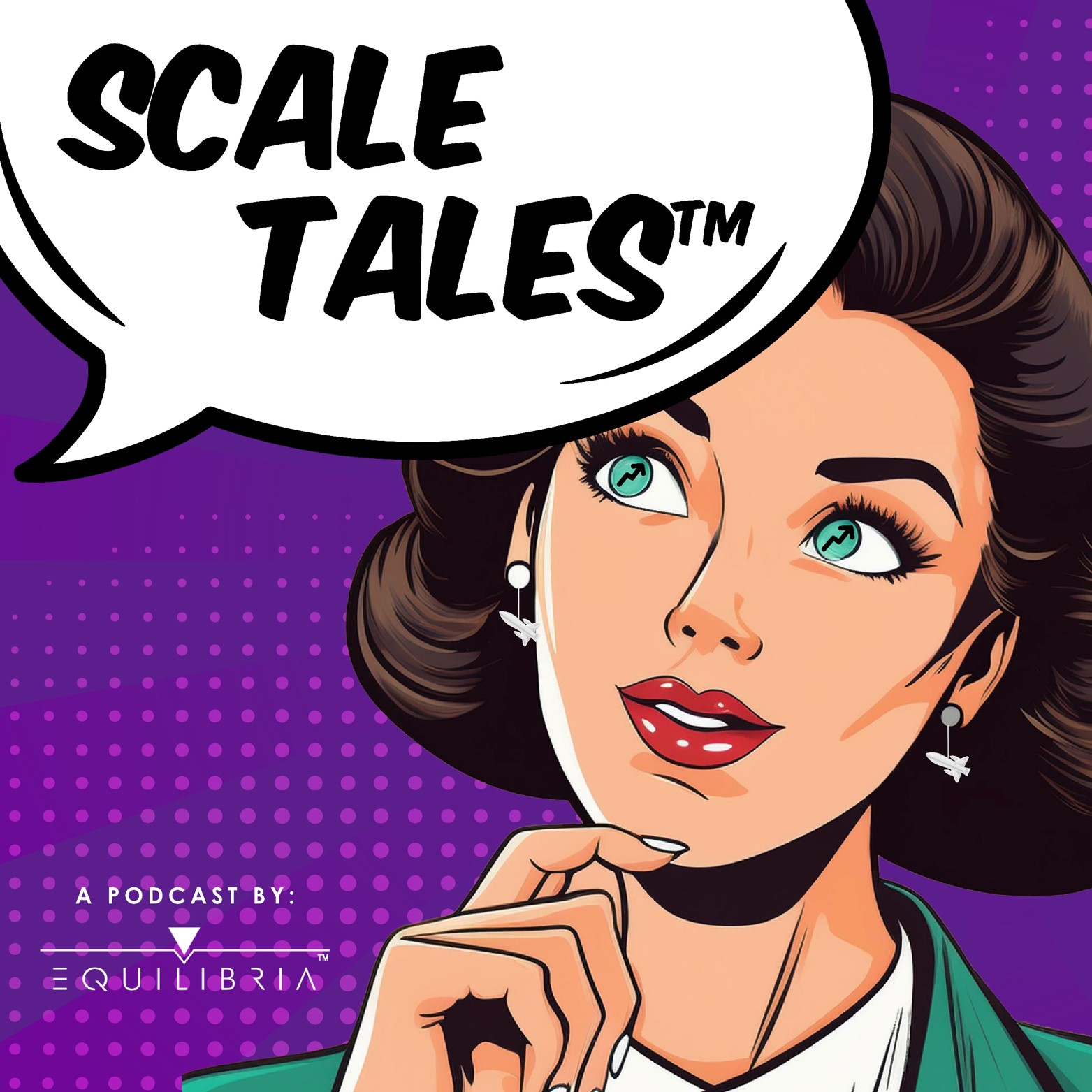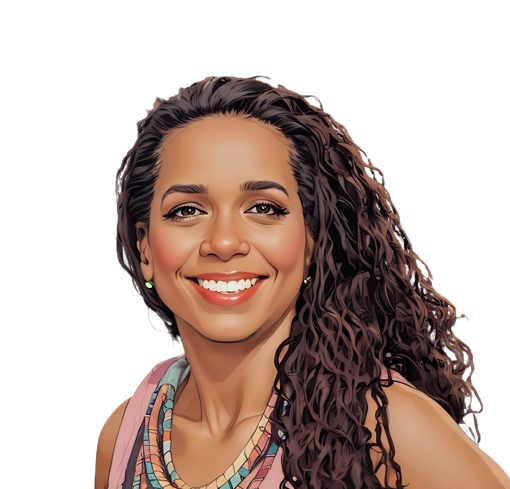Transcript
This episode is brought to you by Equilibria, Inc. Equilibria provides training to assist fast-growing companies in documenting and improving their key processes for maximum operational performance. Visit EQBsystems.com to stop the chaos of fast growth and start flowing today! EQBsystems.com.

Welcome to Scale Tales – the business storytelling podcast where entrepreneurs, executives and experts share firsthand accounts of those magical moments when they achieved something bigger than even they could have imagined.
I’m Alicia Butler Pierre. AI seems to be all the rage right now. For some it’s another technology buzzword, but for others they are using it to make real, measurable, and impactful change to solve global problems. Our next tale comes from across the pond in the U.K. by someone who is determined to address the global early childhood education crisis.

This is Ep. 18: How Dr. Pauldy Otermans Grew Teddy AI to 2,000 Users in Less Than One Year
Hi everyone, I’m Dr. Pauldy Otermans, principle and chair of Otermans Institute and creator of Teddy AI. I’m currently in London and this is my scale tale.
It started around 2020 so let me tell you a little bit about my journey and then I’ll tell you how I got to where I am today. I’m a cognitive neuroscientist by background. That’s where I did my PhD in many years ago and I’m now one of the top female AI innovators in the United Kingdom. And I’ve won a number of awards in this area and also worked on a number of projects.
For instance, one with Innovate UK on the subject of AI in education. And that’s what I want to talk to you about today. If I bring you back to 2020, which I know and we probably don’t really want to talk too much about 2020 because it was a lockdown year. However, myself and my co-founder launched our company Otermans Institute, which was at the time a traditional EdTech company where we taught human trainers, learners one to one, one to many, over Zoom.
We got a lot of positive feedback and we scaled that solution which was all about upskilling people. Whether it was employability skills training, like how to define goals, how to create a CV, communication skills, presentation skills, really transferable skills which was very global. We created this global employability curriculum and in that year we scaled to nine countries serve thousands of learners and then we face the bottleneck.
And the bottleneck was that we couldn’t hire enough teachers, that we couldn’t hire enough trainers because there is a shortage of millions of trainers globally. And actually a report came out that said 44 million teachers or trainers are needed just to reach basic education by 2030. Well, that’s quite a lot of people. And of course we were in that same boat. So we thought, Well, human intelligence, what is close to that?
And what came up in our head, AI, artificial intelligence. Now think back, this was at a time when there was no ChatGPT and I think now everybody has used it or another solution, Perplexity, Gemini, whatever it is that you have tried, I’m sure the majority of people now have tried some sort of gen AI tool, but at the time this was not there. So we started experimenting and I still remember and now it’s quite funny, at the time it wasn’t, me and my co-founder wrote thousands of lines of code to get our first AI up and going. And we launched it.

Now as I said, we were in the COVID 19 period. UNICEF and the UN reached out to us for help to support those learners that definitely couldn’t go to school. Maybe Internet was also a bit of a problem in terms of not everybody had individual access, but they could still come together in classrooms. And we said, “Sure, why not?” So we launched the world’s first digital human teacher, completely powered by AI to refugee learners and displaced learners in UNHCR BCF camps in northern Iraq.
And we were there looking probably from a very old device which had one webcam. We could look sort of inside the classroom, almost like this bird’s eye view. And the learners there was about five or six of them and they were given a device, one of these older phones that probably was one of the first smartphones that they had there and they got the link and they tried our AI teacher.
And then there was silence.
16 minutes of silence. And when you’re first launching a product and you want to get people to test it, it’s already nerve wracking because you have no idea whether they like it, if they can understand the flow because you thought about it as a team and you try to make it as easy, as simple as possible, but you never know someone an outside perspective whether they understand. So, after 16 minutes of silence, one of our learners, her name was Aisha, she looked at her phone, she looked up to the screen and she said,
Wow! She speaks to me!
Our AI teacher at the time was Beatrice. So that’s when we knew this is something worth pursuing. And that got us the motivation to where we are now. So fast forward a little bit now we have our AI teacher. Version two is in market focusing both on corporates as well as education institutions to make learning outside of the classroom or traditional workshop setting, two-way conversational. So our clients can upload their content, their PowerPoints, their policies, their security protocols to our dashboard and then the AI will extract the relevant data from that and creates a lesson.
And you as a human are always in the loop, you can choose how many chapters, how many subtopics, how long should that topic be? What sort of activities do you want the learners to do with AI – is it multiple choice questions, open ended questions, scenario based? You are always in control as a human. And then the lesson, you publish it to your learners.
They can go through the content with the AI teacher, ask questions, interrupt her, clarify doubts, delve really deeper. The AI quizzes them, then all the data can feed back to the humans again in the loop, the manager, the educator, to see how their learners actually doing. Maybe what we see is, well, these people, everybody seems to not understand a particular concept.
Maybe we need to do another workshop and really bring everybody on the same level or particular individuals seem to struggle with this. Well, let’s take them out of the workflow and discuss to see what we can better do to support them. Because depending on what job it is, but if it’s related to security or policies, you could risk fines or even lives could be at stake.
Dr. Pauldy and her co-founder tested the viability of their AI software and this radical idea of having a “digital human” deliver training. The evolution of their solution happened fast and paved the way for another invention.

Now, then we started talking to parents and generally lots of people we know at this time. I’m of this age where a lot of my friends have children and as you go for a chat, for a walk, one of the things we discuss a lot is screen time. And you may yourself also be a bit worried about screen time and young children and is this beneficial? Is it harmful? There is a lot of debate out there on this topic. So this is something I discuss with a lot of my friends especially those who have young children.

But guess what happens every time we sit in the coffee shop, order our coffee, we all sit at the table and here comes a tablet or the mobile phone handed to the child to keep them busy. And often my friends are quite guilty when they do that. And when I ask them, “Tell me, about this screen time, right? Because this is the first thing they do when we sit down.”
And usually what comes out is, yes, they know maybe the name of the game they’re playing or the YouTube channel they’re watching, but that’s about it. They actually don’t know what’s going on. This gave us the idea of Teddy AI because parents really want to be involved in the child’s educational journey. When a new child is born, you want to nurture it, you want to be part of their development, part of their learning. You want to be there every step of the way. And maybe in the first few years we can do that. But then they may go to nursery and primary school. And what we as parents usually rely on is what the child says when they come back from school, how things were and what they did well in and whatnot.
Some report cards, but they’re a bit distance. There are some numbers written on there and maybe that’s about it. And sometimes we may have, parent teacher meetings where we hear a bit more about our child’s learning, but those are actually quite a few snippets. This is not the entire learning and development of the child. So you know what, we thought, this is quite a big problem. Parents do give their children quite a lot of screen time.
They’re not really knowing what’s going on when that screen time is taking place. Also they want to be involved in the educational and the learning and development of the child. And they may be busy because they have jobs, maybe their shifts don’t fit with the child’s lifestyle in that way. So it’s very difficult for a lot of parents to be involved. There can be a million reasons why they may not be able to.
Considering the busyness of many parents, Dr. Pauldy and her co-founder sprang into action. It seemed Teddy AI could be just the solution these parents needed to become active participants in their children’s education. They began asking probing questions regarding digital learning content available through things like YouTube and games.
But when we asked them, they actually had no clue what this learning content was and they couldn’t really contribute to what they wanted their child to learn. This is really where the idea of having an AI study buddy for children that can listen and understand children came from. But also, it goes one step further. Teach the children what their parents want and report back to the parents. So, Teddy AI is completely powered by generative AI and there’s nothing to be worried about or scared about, as some people are, because Teddy uses our own specialized language model so that’s not connected to the Internet and it takes up all these random sources of information.
No, it is fine tuned for the ages between four to seven. And speaks in a child friendly language, uses child friendly vocabulary. But because it’s generative AI actually speaks very differently to everyone. It’s hyper personalized. So let me give you an example.
All of us, I hope, we watch Winnie the Pooh when we were younger and when you watch episode three and I watch episode three, we watch the same thing. We may chat later on about that, but we watch the same thing. In this case, I can talk with Teddy about the rainbow. You can talk to Teddy about cars.
My friend’s niece can talk to Teddy about dolls. My other friend’s son can talk to Teddy about the weather. Everybody can talk to Teddy about what they would like to talk about. And all these conversations can happen at the same time and are all personalized. But that’s the view of generative AI.
It’s also worth noting that Teddy AI comes programmed with 100 games focused on helping children learn and upskilling them.
At the moment, it’s very much focused on the UK curriculum because we are a UK-based company. But key stage one and two are quite globally applicable. I would say that’s what they’re based on at the moment. As a parent, where do you come back into this picture? You can prompt Teddy, request Teddy to teach your child anything you would like them to learn.

Now, this could be something from their report card maybe they’re not so good at the multiplication of two, or maybe there is something within your own traditions that is really important to you and you want your child to learn or, you know, the importance of brushing your teeth.
How many children are like, Oh no! I have to brush my teeth. How many parents struggle with getting their children to bed? Those are things Teddy can also teach. So it’s not just academic, it’s also emotional intelligence, social skills, anything you want.
And this can be especially helpful when children ignore or disobey their parents, but somehow listen to the same request or directive once given by someone else. Dr. Pauldy has an example of Teddy AI’s ability to serve as parental reinforcement.
One of my friends, they were very busy, they’re working, not always there to sit down with the child in the evening. Often it’s there already when the child is in bed. They told Teddy,
“Can you please tell Bella to wish grandma happy birthday tomorrow because she should not forget and maybe you can also ask Bella to make a nice drawing for her grandma?”
So when the child started playing Teddy the next day, Teddy talked to the child and say,
“You remember it’s Grandma’s birthday, maybe you should make a big drawing for her. Shall we do that together?”
And of course, there you go. The child made a lovely birthday card. So why am I telling you this? We really saw, a market out there. That no matter where you’re from, no matter what country you grew up in, no matter what education system you’re used to as a parent, you want to be involved in your child’s journey. Now, how do we scale this then? It took some time, I won’t lie. Okay. It is not an easy journey. There were struggles along the way.
Remember, Dr. Pauldy started on this quest to democratize education back in 2020. By November, 2023 Teddy AI was no longer just an idea. It was officially a company with a product ready to be tested on a larger scale.
Teddy is available on the Google Play Store, and we tested it. We went to talk to children, tons of children.
We reached out to local schools in the area where me and a few of our team live, and we said, “Can we come and have the children play with Teddy? There’s no cost to you. We just want to come and see how the children are interacting with it.” Because that was our first focus point. The child needs to understand and the child needs to love it. Otherwise, there’s no point even going to talk to the parents, because in the end, no, the child is, in this case, the user.
So, Dr. Pauldy and her team set out testing Teddy AI in real time at different schools. That’s when they observed…
We couldn’t get the phones away from the children. I mean, maybe they were too excited to get out of the classroom for 10, 15 minutes. But they loved it.
They absolutely loved it. We sat down next to them and saw how are they navigating on the app? What are they clicking on? Because it’s voice first. Do they understand how to navigate the mic? I’m impressed. Four and five and six years old, know a lot about technology. And they gave some amazing suggestions, too! They loved certain things to be added, certain topics to be learned about.
There is also a store when they play the games, they get coins, and then they can purchase on the app. They had lots of ideas so that gave us two pages of ideas that we could further implement, which of course we have done subsequently.
Once they knew they had a product that their users loved, it was now time to extend their testing to teachers. Specifically, Dr. Pauldy and her team wanted…
To hear from an education expert point of view, they are the ones that are teaching these children, what do they think about it? And again, they loved it.
Okay, so far so good. They are two for two now. But there’s still one more group to test – parents! Interestingly, they decided to not extend testing to the school system itself, at least not for now.
We’re first focusing on the parents. Is that the wrong move or right move? I guess, you know, time will tell because we thought it’s very complicated to integrate this into the school system from the start. We first wanted to go and talk to the parents, get them involved, because a lot of schools already have a lot of technology at their disposal. And we thought, let’s talk to the parents first and get them involved in a child’s journey. So then we tested with parents. Again, we got lots of feedback.
What was the feedback from parents? They ultimately have the power to make or break Teddy AI. Would they love it just as much as their children and their teachers? Would they hate it? Would Dr. Pauldy be able to achieve the scale she envisioned? We’ll find out after the break.
Some small businesses fail not from the lack of customers, but from too many. When your business receives positive publicity, it’s exciting! The spotlight attracts more customers and the cash flows in. But too much growth too soon can be catastrophic especially if your organization lacks the business infrastructure to support this growth.
Behind the Façade: How to Structure Company Operations for Sustainable Success is a book that introduces a proven framework for building business infrastructure. The book is structured into six relatable stories of entrepreneurs who apply this framework, giving you an inside look at how they solve their fast growth issues and how you can too! Pick up your copy today at ScaleTalesPodcast.com. ScaleTalesPodcast.com.
Welcome back! Before the break, Dr. Pauldy Otermans, a neuroscientist, took us to the early days of her quest to make basic education accessible to the masses. She shared how her first company paved the way to her latest invention, Teddy AI – a digital study buddy for children between ages four and seven. She had successfully tested Teddy AI with children and their teachers, but now it was time to test parents. Would they also love Teddy? Here’s Dr. Pauldy…
We sat one to one, we did some focus groups, we did interviews. Lots of different ways of engaging with them, but all very detailed. Talking to one parent at least took half an hour, 40 minutes. We did some survey work too. Of course you can easily reach 100, 200 parents, but we did a lot of in depth discussions with them as well, which gave us a lot of rich data. The feedback was,

“I love this app! My child will definitely benefit. I can see how Teddy AI can help them in their learning. Now, how can I get involved?”
They wanted to see the feedback. They wanted to know, Okay, how much time did my child play on the app? What sort of games did they play? What did they learn today? Has their vocabulary increased? Particularly with the younger ones, they’re picking up lots of new words all the time. So that’s when we created the dashboard fully based on all this feedback we got from the parents. And it is now live.
Parents can log in, add their child’s ID to their dashboard account, and then they can request prompts and Teddy will execute them without a child knowing. This is like a forced activity. It comes within the play time that the child has with Teddy, and then Teddy reports back with very simple analytics: time spent, words learned, games played, whether the child actually did the request the parent asked them to do, and how they performed.
So, if I would say, “Please talk to my child about the multiplications of two.” Teddy may do that in the way he does and then Teddy may report back and say,
“Your child knew 1 times 2 is 2, 2 times 2 is 4, 3 times 2 is 6. And then they struggled.”

So now the parent knows exactly where the child is in their development journey. That’s why it has taken us quite a lot of time to reach a lot of people.
At the moment we have about 2000 ish people that are active on the Teddy AI app and we are slowly starting to scale the number of parents as well because we are still fine tuning and really making it almost perfect so that the PAR can use it especially with the linkage of the payment gateways, et cetera. Now we are working with the Google Beta family for instance.
That’s definitely one thing I would recommend if you’re having a product that’s an app, you get lots of detailed feedback. Not just this is great, but this is great, but I would add XYZ. Product Hunt is something as well that we’re using a lot to grow our use case and get feedback at the same time. And then your own circles.
As I mentioned, I’m at the age where a lot of my friends have children. So reaching through them and then having that, you know, trickle on effect and word of mouth because all of them are part of parent groups, whether it’s WhatsApp groups or meetup groups. So that way we are scaling firstly and then of course the marketing piece comes with it in terms of the budgets and the social media posts as well.
And in case you’re wondering, there is a free version of Teddy AI available on Google Play.
Your child can spend as much time as they want talking to Teddy and playing the games. But if you as the parent want to influence, what your child is learning and actively be involved in that, yes, you make your account which is free, you get a few free requests. I believe it’s three at the moment. and then you pay, you buy the request to further prompt Teddy. And there are different packages that you can choose from depending on how many you would like. You can either do that at a pay-as-you-go basis or you can do a monthly subscription, depending on what your preferred style is.
Are you curious about how Teddy AI works as a generative AI tool? Do you remember that nerve wracking experience Dr. Pauldy described at the beginning of her scale tale? The one where they provided access to education for child refugees through digital humans? Well, that was the starting point of data they collected which over the years was initially used to program Teddy AI
And that’s the second chunk of time that was used in order to fine tune our own model, make it child friendly. Certain words we don’t want children to say, right? So the model shouldn’t have these words. And if a child asks questions about these, of course Teddy should reply back, “I don’t know,” something along the lines of, “Ask a grown up,” or, “This is something you will learn when you’re older,” or whatever he may say.
And actually you also need to comply with the regulations before you upload it to the Play Store because it is a product for under 13 years old. So we have to, comply with that in terms of where the data came from. Yes, it was, all the interactions we have been having with these thousands of learners and then adding the requirements of the National Curriculum of the UK into that so that the model understands what it should focus on and what it shouldn’t.
And then indeed putting in these boundaries of the things that Teddy shouldn’t be talking about and then making it child friendly in terms of the way we converse today is different if I was talking to a five-year-old because they wouldn’t use the complicated words and the way they construct the sentences is different. So that also was the next layer, all these layers had to be done.
With 45,000 learners reached via the Otermans Institute and now 2,000 users and counting with Teddy AI, I couldn’t help but wonder, what’s next for Dr. Pauldy?
I was already laughing when you said that. You know me. I find that’s an interesting yet difficult question because I think when you have your own company and you see your own product grow, you always set the next milestone to reach. And sometimes you don’t know yet what that milestone look like.
What does the market tell you? What do your parents, want? Because ultimately these are your clients, the children are the users. I think at the moment, for me, how success looks like is, you know, if every child talks to Teddy and that, gives them the confidence for public speaking, makes them learn more the things they want to learn. And also makes the parents happy that they’re involved in the child’s journey. Now, this is very abstract, right? There are no numbers to it.
One can say if a million users use Teddy, that could be what success looks like. A million parents access the dashboard and they sending on average 20 requests a month. So almost every weekday of the month they send a request to Teddy to teach a child. That could be what success looks like. However, one final thing I would like to add to the story, which is I guess the final bit of the story I know I talked about different platforms. We will use our own word of mouth, social media, we take out all the tools of the marketing toolbox that many people use when it comes to marketing and advertising products.
However, we now can use Edge AI. This is a scalability piece because this can increase access to millions of people as the cost of these large language models drops by 70%. And, the data of our children, this is private data. The children are talking to the Teddy bear, they’re typing things, but also their voice because they use the mic, of course, much more safer because it doesn’t need to leave the device. With Edge AI, what happens is your language, or our language model in this case, runs on the device and we’ve already shown last month that this is possible.
What that means is when you download Teddy and you interact with him on the app, your data doesn’t need to leave the device anymore, your latency reduces, which is better. It’s all going to be quicker to talk to him, which is lovely from a user’s point of view. And our costs go down because at the moment, every time someone talks to Teddy, it hits the cloud, it goes back, Teddy responds, the child says something again, goes to the cloud and Teddy up and down. And all of these instances are costs. Now, when it runs on your own device, those costs are no longer there because the model runs locally. And for a parent’s point of view, particularly because this is a children’s product, your data, all of this personal data, does not need to leave the device. That will be a bigger scalability piece.
And part of that bigger scalability piece means expanding Teddy AI into different countries and eventually different languages.
It is a variety of countries, of course. There’s quite a lot in the UK, because that’s where we’re from, but also the US, India, it’s all over the world, really. I can’t tell you all the different countries because some you really have just a handful of users. I think there’s quite a few in Brazil as well. There’s some in the Netherlands, that’s where I’m originally from. So all my friends are using it, I guess.
However, another thing that we can do is tune our language model into a different language. So retrain the model and let’s say make it in Spanish. Spanish we already have. It’s not yet pushed out. It’s in beta version at the moment. We really want to fine tune and test it a bit more, particularly when it become meant to make it child friendly.
But that’s also something we can do. As we continue to scale, we’re also focusing on making many, many more languages available not just by putting a translation layer in between, let’s say English and French or English and Italian or whatever it may be. But we’re retraining the model in that language and making it fit for purpose for that language.
So that is a second scalability piece as well if you want to reach other learners in other countries, particularly when the children may be bilingual or bilingually raised because of the schooling system. Often schools are nowadays many, many more times in English than it was a few years ago. But the parents may still want to stick to their native language and want the child to be bilingual in the end.
As we all know, technology changes rapidly. As of this recording in December of 2024, Teddy AI is not currently available in the Apple Store, but…
Soon it will be. Don’t worry. We know there’s a lot of people with iOS out there, so you can find out more information on www.teddyai.com. Also underneath you will find a link that you can also sign up to get more information on the parent dashboard and find out more and join our community, join us as a parent, be part of our community and could contribute to developing Teddy even further.

You know, as much as I’ve heard Dr. Pauldy speak, I continue to be amazed every time I listen to her. Her vision is grand and her mission is fueled by that large education gap she mentioned at the beginning. You may not be a technologist, but that’s okay. There are still valuable lessons to learn from Dr. Pauldy’s scale tale:
- Observe the world around you. Be present. It may spark an idea for your next invention.
- When you have an idea, don’t invest in it full throttle. Instead, develop a prototype or an MVP – Minimum Viable Product – first and then test it.
- Your end user may not be your only customer. Consider the entire ecosystem of people that your customer is a part of. These are also people that you’ll need to sell your product or idea to.
- A major way to scale a product or service is to identify a large, untapped need and provide a solution that is easy to access.
- If global expansion is part of your plan to scale, you must account for differences not only in language, but time zone differences, geographical differences, and differences in cultural and societal norms as well.
I had the pleasure of meeting and getting to know Dr. Pauldy Otermans when we both spoke at the 2024 TEDx Viikki event in Helsinki, Finland. Her quest to close the education gap is admirable and I’m fully confident that the number of Teddy AI users will expand into the hundreds of thousands within the next two years. Who knows? It may even crack 1M users by 2026.
You can learn more about Dr. Pauldy, the Otermans Insitute, Teddy AI, and other resources she referenced in this episode’s show notes. Visit ScaleTalesPodcast.com. Again, that’s ScaleTalesPodcast.com.
Thank you for listening! If you learned something valuable from this episode, please leave us a five-star rating and review wherever you’re listening.

I’m Alicia Butler Pierre and I produced and narrated this episode. Soleil Levy provided the voiceover for Teddy AI. Audio editing by Olanrewaju Adeyemo. Music production and original score by Sabor! Music Enterprises. Video editing by Gladiola Films.
You’ve been listening to Scale Tales, a podcast by Equilibria, Inc.
















